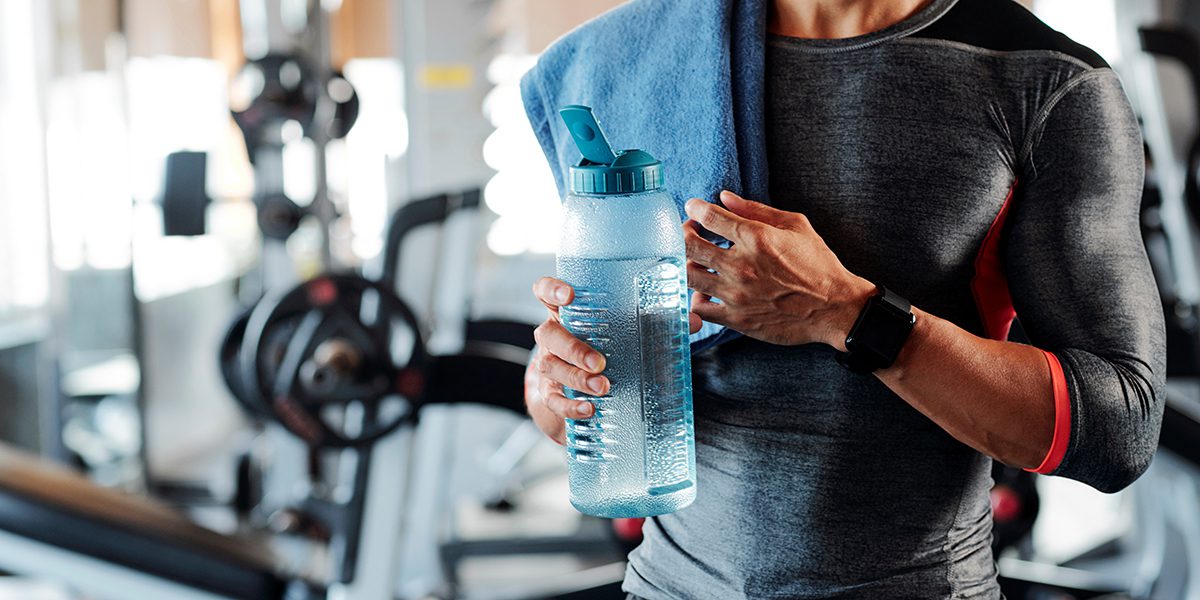WRITTEN BY WOODSIDE DIRECTOR OF TRAINING, JOHN BEANE
The fitness industry can be a bit tricky to navigate. There is rarely a sure thing in our industry and even in those instances there is most definitely a social media guru that will inevitably cherry pick information to contradict the idea – gotta get those clicks. At this point we believe it’s fairly safe to say that hydration and its link to performance would fall under the category of “sure thing.” Hydration plays a crucial role in optimizing both physical and cognitive performance. Whether you’re an elite athlete or a casual fitness enthusiast, maintaining appropriate fluid balance is fundamental to your success and overall health. Dehydration, even at mild levels, can impair physical abilities, reduce endurance and negatively impact mental function. On the other hand, optimizing hydration can enhance performance, delay fatigue and improve recovery times. This blog post will explore the science of hydration, its direct impact on performance and strategies to maintain optimal hydration levels. Before we get started with the science of hydration I’d like to define performance for the purposes of this article. When we hear the term “performance”, we typically think of an elite athlete training and competing at high levels. This is totally understandable, but there is much more to what performance can mean. We are using the term performance to define your ability to accomplish an action, task or function. This includes everything from making it through a stressful day of work feeling energized, pushing through the last five minutes of a class in The Lab or making it through a Chiefs night game without a raging headache the next morning. A good hydration strategy can be an absolute game changer for optimizing performance.
THE SCIENCE OF HYDRATION
As is the case with all of our blog posts, before we dive into benefits and interventions, we want to make sure we cover what hydration actually means in the context of physiological processes. Hydration refers to the body’s capacity to maintain fluid balance – ensuring that cells receive the right amount of water for metabolic processes (Shirreffs & Maughan, 1998). The body is composed of approximately 60% water, and maintaining this balance is essential for nearly every biological function, including thermoregulation, digestion, nutrient transport and cellular homeostasis (Sawka & Coyle, 1999).
At the cellular level, hydration is maintained through the interaction of water and electrolytes – substances like sodium (Na+), potassium (K+) and magnesium (Mg2+) that help regulate osmolarity, which is the balance between water and solutes across cell membranes. Electrolytes play a key role in nerve function, muscle contraction and the balance of fluids inside and outside cells (Kenefick & Sawka, 2007). Sodium, in particular, is critical for maintaining blood volume and supporting cardiovascular function during exercise, as it helps retain water in the extracellular space. Potassium and magnesium, meanwhile, regulate intracellular water and are crucial for muscle contractions and preventing cramping (Hew-Butler et al., 2015). Electrolytes also influence the body’s ability to regulate temperature and maintain optimal physiological performance during periods of exertion. When we sweat, we lose both water and electrolytes. Without replenishment, the resulting imbalance can lead to a cascade of issues, including impaired muscle function, reduced nerve signaling and decreased exercise capacity (Shirreffs & Maughan, 2000). It’s essential to maintain this balance, especially in high-intensity or long-duration activities, through both water and electrolyte intake to prevent dehydration and electrolyte depletion (Kenefick & Sawka, 2007).

We also know that proper hydration can have a positive influence on hormonal balance in the body. The endocrine system, particularly the hormone antidiuretic hormone (ADH), plays a pivotal role in regulating fluid balance by controlling water reabsorption in the kidneys. ADH increases in response to dehydration, prompting the kidneys to conserve water, which helps prevent further water loss but also increases the concentration of electrolytes in the blood (Casa et al., 2000).
BENEFITS OF PROPER HYDRATION
Now that we understand the science and physiology of hydration, let’s cover some of the key benefits. Adequate hydration provides numerous physiological benefits, which directly enhance performance:
- Thermoregulation: Water helps regulate body temperature by dissipating heat through sweat, preventing heat-related stress and maintaining optimal conditions for enzymatic activity (Casa et al., 2010).
- Cardiovascular Efficiency: Hydration ensures blood volume remains adequate, allowing the heart to pump more efficiently and deliver oxygen to working muscles (Sawka & Coyle, 1999).
- Muscle Function and Recovery: Water is critical for muscle contraction and joint lubrication. Proper hydration also speeds up recovery post-exercise by flushing out metabolic byproducts (Shirreffs & Maughan, 2000).
- Cognitive Function: Even mild dehydration (1-2% body weight loss) can impair cognitive abilities such as decision-making, attention and motor coordination (Gopinathan et al., 1988).
PERFORMANCE DETRIMENTS OF DEHYDRATION
It goes without saying that there is a cost to not being properly hydrated. Dehydration can have a profound negative impact on performance, particularly in endurance sports or prolonged physical activities. The body loses water primarily through sweat and respiration, and failure to replace this lost fluid can lead to detrimental outcomes. This includes decreased Endurance and Strength. Dehydration reduces blood volume, increasing heart rate and reducing the body’s capacity to deliver oxygen to muscles. This results in premature fatigue and reduced strength (Montain & Coyle, 1992). Dehydration also can cause an increased Risk of Injury. Dehydration reduces joint lubrication and muscle elasticity, increasing the risk of strains, cramps and injury (Casa et al., 2000).
Recognizing the signs of dehydration is critical to preventing the detrimental effects it can have on performance and overall health. Early signs include increased thirst, dry mouth and reduced urination, which can be darker in color. As dehydration progresses, more severe symptoms may appear, such as dizziness, headaches and muscle cramps due to the loss of electrolytes. Fatigue and cognitive impairment often accompany physical signs, as the brain becomes less efficient with reduced hydration levels. In extreme cases, dehydration can lead to heat exhaustion or heatstroke, which are medical emergencies that require immediate attention (Casa et al., 2000). Understanding and responding to these signs early can prevent a decline in performance and reduce the risk of serious health complications.

RECOMMENDED HYDRATION STRATEGIES
Hydration strategies must be individualized, as sweat rates, activity levels and environmental factors vary. One of our favorite go-to resources on the Woodside Training team is Dr. Andy Galpin. Dr. Andy Galpin recommends a strategic approach to hydration that considers both water and electrolyte replenishment. Listed below are strategies for hydration that include his electrolyte recommendations:
- Pre-exercise: Begin exercise well-hydrated. Drink 500-600 mL (17-20 oz) of water with a pinch of salt to optimize sodium levels 2-3 hours before activity (Casa et al., 2010).
- During exercise: Consume 150-350 mL (5-12 oz) every 15-20 minutes during exercise, adjusting based on sweat loss. In high heat or humidity, fluid intake should be increased (Sawka & Coyle, 1999). For activities lasting longer than 60 minutes, supplementing water with a balanced electrolyte solution (500-700 mg of sodium per liter) prevents dehydration while avoiding excessive sodium loss.
- Post-exercise: After physical activity, aim to replace 150% of the fluid lost. This typically equates to consuming 1.5 liters of fluid for every kilogram of body weight lost through sweat (Shirreffs & Maughan, 2000). To accelerate recovery, pair with electrolytes to restore plasma volume and aid muscle recovery.

Hydration is a cornerstone of both physical performance and recovery. Proper fluid and electrolyte balance optimize cardiovascular function, muscle efficiency, and cognitive clarity. In contrast, even mild dehydration can significantly hinder performance and increase the risk of injury (Casa et al., 2010). An easy way to gauge hydration status is through the color of urine – pale yellow generally indicates adequate hydration, while darker urine signals dehydration (Armstrong, 2007). Additionally, paying attention to how often you feel thirsty, checking the frequency of urination and monitoring your energy levels can be simple yet effective ways to assess hydration.
Following individualized hydration protocols, such as Dr. Andy Galpin’s, which emphasize both fluid intake and electrolyte replenishment, can make a substantial difference in performance outcomes (Huberman & Galpin, 2023). Before we wrap up it is important to know that there is no one strategy that works for everyone so it’s not about trying to be perfect all the time, it’s about doing your best and being as consistent as you can. Don’t panic if you feel like you haven’t met your hydration goal for the day, chances are there was enough water in your food to make up for it. Everyone is busy and it’s impossible to get everything “right.” Simple things like keeping a glass by your sink as a reminder to have some water when you wake up, keeping a water bottle in hand during your training or taking a sip of water every time they show Taylor Swift during the game can all help you stay on a track. Again, if you do your best to be proactive with your hydration and find a strategy that works, improvements in your performance will be pretty much a “sure thing.”
Our team of Trainers can help you incorporate a focus on hydration into your wellness routine. To learn more click here or email us.
